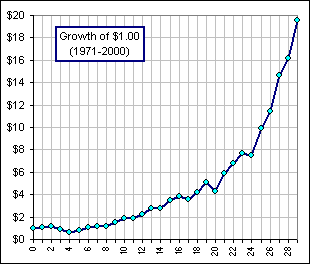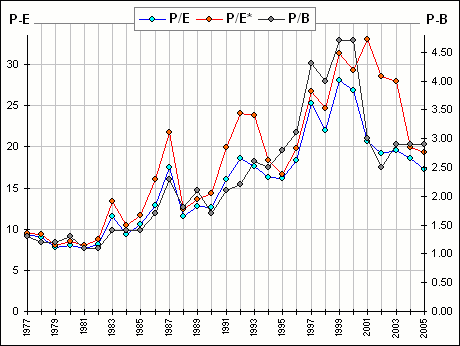| Retirement ... with your head in the sand |
It's Jan 1, 1971 and Sam has just retired at age 65.
He'd like to calculate a "safe" withdrawal rate from a portfolio that he intends to maintain as 25% each of Large and Small Cap Growth and Value.
>By rebalancing each year?
Yes. Now Sam is a very careful planner and he'd like to consider withdrawals until he's 95 years old ... a 30-year scenario.
He also intends to increase his withdrawals whenever inflation is positive.
This is what he does:
- He looks at the worst case, historical 30-year scenario (in the 1928-1970 range) and finds that a 4% withdrawal rate seems pretty safe.
- He also does 10,000 Monte Carlo simulations, selecting random returns (and the inflation rate) from a random year in the 1928-1970 range ... and finds that only about 80% of portfolios would survive a 4.5% withdrawal rate.
- He then decides that he'll withdraw that "safe" 4% (increasing with inflation, if inflation is positive).
|
>And?
>A one million dollar portfolio? In 1970? You kidding?
>Twenty million? You kidding?
So what's the moral here? >Uh ... I give up.
|  Figure 1 |
There's a spreadsheet that can do the calculations and ...
>What's it look like ... that spreadsheet?
Like this:

Click the picture to get the spreadsheet!
>Huh?
You do this:
- Pick four assets in cells G3 to J3 (from a list of ten).
- How you intend to allocate your portfolio (with annual rebalancing) in B2 to D2.
- The number of years you intend to withdraw from your portfolio, in cell B3.
- The withdrawal rate in cell B4 ... which will increase when inflation is positive.
- Pick the number of Monte Carlo simulations in D3.
- Pick a range of years in H6, H7.
- Stick some year in cell D9.
- Click a button.
You also get the Monte Carlo survival rate starting in the year you selected in step #7.
(These Monte Carlo simulations select random returns from the year in step #7 and those years after that year.)
You also get a chart of a $1.00 Portfolio, using the actual, chronological sequence of returns and inflation rates.
(That is, there ain't no Monte Carlo here.)
>And that chart which says: "Max Withdrawal Rate"?
Oh, yeah ... forgot. Them's the actual maximum withdrawal rates, starting in year 1928.
Anything larger and your portfolio wouldn't have lasted the number of years you specified in cell B3.
>So why do the years only go up to year 2000?
In that year I spent an inordinate amount of time collecting data (see this)
and I'm too lazy to do it again.
>I see where that infamous 4% "Safe" Withdrawal rate comes in!
Yes, that chart is interesting.
One should be able to look at a chart of how "the market" is behaving - that'd be some sort of "current market valuation" -
and determine what valuations gave a good indicatiuon of how much one should withdraw.
>Yeah, so when are you gonna do that? I mean, investigate appropriate "valuations"?
I did play with that here, where one looks at E10/P (for the S&P500)
to determine how much to withdraw 
>Okay, so what's this E10/P?
Look at the tutorial I just linked and all will be revealed 
>And is that E10/P a good indicator of how much to withdraw?
You decide:

Note that the Max Withdrawal Rates and the values of E10/P (from 1928 to 1970 ... the right-hand chart) are highly correlated.
If one accepts the equation describing that correlation, then you should start your retirement with a withdrawal rate of about
1.81 (E10/P) - 0.02.
With a current E10/P value of, say, 2.3% (or 0.023, in year 2000) that means we should consider starting our withdrawals (in year 2001) at
1.81(0.023) - 0.02 = 0.022 or 2.2%.
>Increasing with inflation?
Yes.
>And you believe all this stuff?
Is that relevant?
>What about E10/P? Do you think one should use that as a guide to a "safe" withdrawal rate??
A guide? Sure, why not? We need all the guidance we can get.
However, you may have noticed that, by the end of 1970, the value of E10/P was 5.9%.
(See the big magenta dot?)
If Sam had used the magic equation: y = 1.81x - 0.02 he'd be withdrawing 1.81(0.059) - 0.02 = 0.0869 or about 8.7% for the next 30 years.
However, the maximum he could have withdrawn (to survive for 30 years, starting in 1971) was less than 7%
... see the right hand chart, in the picture of the spreadsheet.
Had Sam actually withdrawn, say 6.9%, his portfolio would have died by 1996.

|
>Okay, so what's all this "head in the sand" stuff?
Oh, didn't I mention it? That's where you determine, by some esoteric scheme, some so-called "safe" withdrawal rate, follow it blindly, ignore market machinations, ignore the size of your portoflio, ignore ... >Yeah, yeah. Head in the sand ... so now that you're retired, what do you do?
|
|
| Current Valuations ... what to choose? |
That may (or may not!) be adequate, but then what else can one use?
I guess one might look at just the P/E Ratio (where negative earnings are included ... or not), or maybe the P/B Ratio, or maybe ...
>P/B?
The Price-to-Book ratio.
Anyway, Figure 2 plots P/E (not including negative earnings)
and P/E* (including negative earnings) and P/B, from Jan, 1977 to Jan, 2005.
| Note: when you include negative earnings, E goes down so P/E goes up.
>I thought you'd look at the reciprocal, like E10/P or ...
 |  Figure 2 |
>But just for the S&P500, right? So what to use for "current market valuation", E/P or B/P or ...?
Patience, but notice that all of the above (possible) valuations say that they are falling ! 
To see what's best (as a "market valuation"), maybe we should see which provides the "best" prediction of ...
>A Safe Withdrawal Rate!
Yeah, that'd be good, but we have less than thirty years, from 1977, so ...
>So do 10-year withdrawals!
Well, starting in 1977, the Maximum Rate of Withdrawal (MRW), over rolling for 10-year periods ...
>Huh?
You start in Jan of some year and find the withdrawal rate (increasing with inflation) that'll reduce your portfolio to $0 in ten years. That's MRW for that year.
Then we move on to the next year and ... well, the MRW actually goes UP:

>So get more data.
I can get lots of Shiller data
(an .xls spreadsheet that goes back to t = 0),
but I'm still looking for lots of P/B data
... and lots of other possible kinds of "valuation".


